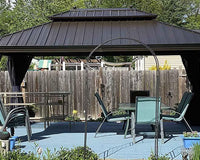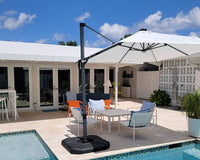Combining shade with smart technology in solar-powered umbrellas transforms our outdoor life. Small solar panels woven into their canopy fabric let these creative inventions convert sunshine into usable electricity to run LED lights and charge your devices. These environmentally friendly umbrellas are becoming more and more popular in homes, beaches, and businesses as more people look for sustainable solutions for outdoor areas since they provide the ideal mix of utility and environmental conscience.
How Do Solar-Powered Umbrellas Work?
Every solar-powered umbrella is fundamentally based on a smart system of photovoltaic (PV) cells deftly spun into the fabric of the canopy. Usually derived from thin, flexible solar panels, these cells gather sunlight all day. Sunlight strikes these panels to cause the PV cells to transform solar energy into electrical power by a mechanism known as the photovoltaic effect.
Usually selected for their balance of efficiency and flexibility, monocrystalline or amorphous silicon panels are used in most solar-powered umbrellas. The generated electricity is then stored in a built-in lithium-ion battery, usually hidden in the umbrella's pole or hub. After sunset, this stored energy can last several hours, guaranteeing that the features of your umbrella stay working long after dark.

What Function Do Solar-Powered Umbrellas Have?
Today's solar-powered umbrellas pack an impressive array of smart features that transform them into outdoor tech hubs. The most visible feature is the built-in LED lighting system, which creates the perfect ambiance for evening gatherings while using minimal stored energy. Many models come equipped with USB ports, allowing you to charge phones, tablets, or speakers directly from the umbrella's power reserve.
To maximize comfort, some advanced models even feature small fans in the canopy and temperature sensors, helping to control the ambient temperature beneath the umbrella. The most recent models go much further, incorporating weather monitoring systems that can alert you to approaching rain or severe gusts. Bluetooth connectivity lets you control lighting brightness, monitor battery levels, and even create automated schedules—all from your phone—so these umbrellas are the ideal mix of shade and clever technology.

Are Solar-Powered Umbrellas Worth the Investment?
Solar-powered umbrellas offer compelling benefits that extend beyond their initial cost:
Energy Savings:
A typical solar umbrella can save 100-150 kilowatt-hours annually when used regularly, reducing dependency on grid electricity for outdoor lighting and device charging.
Cost Benefits:
- Initial investment: $200-500 (average range)
- Yearly energy savings: $30-50 on electricity bills
- Lifespan: 5-7 years (2-3 years longer than traditional umbrellas)
- ROI timeline: Usually achieved within 2-3 years of regular use
Environmental Impact:
- Reduces CO2 emissions by approximately 75-100 pounds per year
- Uses renewable energy instead of fossil fuels
- Most models use recyclable materials in construction
Business Benefits:
- Attracts eco-conscious customers
- Reduces outdoor space operating costs by 20-30%
- Provides added value through device charging services
Where Can You Make the Most of Your Solar-Powered Umbrella?
These versatile solar umbrellas shine brightest in various settings, each offering unique advantages:
Beach & Recreation Spots:
- Charges phones and cameras during beach days
- Provides evening lighting for sunset picnics
- Powers small fans for extra cooling
- Perfect for camping and outdoor adventures
Restaurant & Café Patios:
- Creates ambient lighting for evening dining
- Offers charging stations for customers' devices
- Reduces outdoor utility costs
- Enhances outdoor dining experience

Home & Leisure:
- Illuminates backyard gatherings
- Powers poolside entertainment devices
- Lights up garden spaces after sunset
- Creates a cozy atmosphere for deck dining
Emergency Preparedness:
- Serves as backup power during outages
- Powers essential devices in emergencies
- Provides reliable outdoor lighting
- Functions independently of grid power
What Should You Know Before Buying and Maintaining a Solar-Powered Umbrella?
When shopping for a solar-powered umbrella, start by considering the power output, typically ranging from 25 to 50 watts. Look for models with higher-capacity batteries (at least 10,000 mAh) if you plan to charge multiple devices regularly. The solar panel efficiency rating should be at least 15% for optimal performance, and check that the umbrella comes with a UPF 50+ rating for sun protection.
Weather resistance is crucial for longevity. Choose umbrellas rated IPX4 or higher for water resistance, and ensure the frame is made from powder-coated aluminum or stainless steel to prevent rust. The fabric should be labeled as UV-resistant and water-repellent, typically made from high-grade polyester or Sunbrella material.
Maintenance depends on regular cleaning. To keep the solar panels efficient, wipe them monthly using a soft, wet cloth; as needed, wash the fabric with mild detergent and water. Store your umbrella in a dry, covered space during winter or strong storms; if storing for long, remove the batteries. Every three to four months during storage, make sure the battery is completely charged.
Should problems arise, begin with simple troubleshooting: look for debris on solar panels, confirm the correct battery connection, and check that every port is dry and clean. Resetting the system (typically a button next to the battery compartment) or fully charging the battery using a conventional power outlet will help rectify most charging issues.




